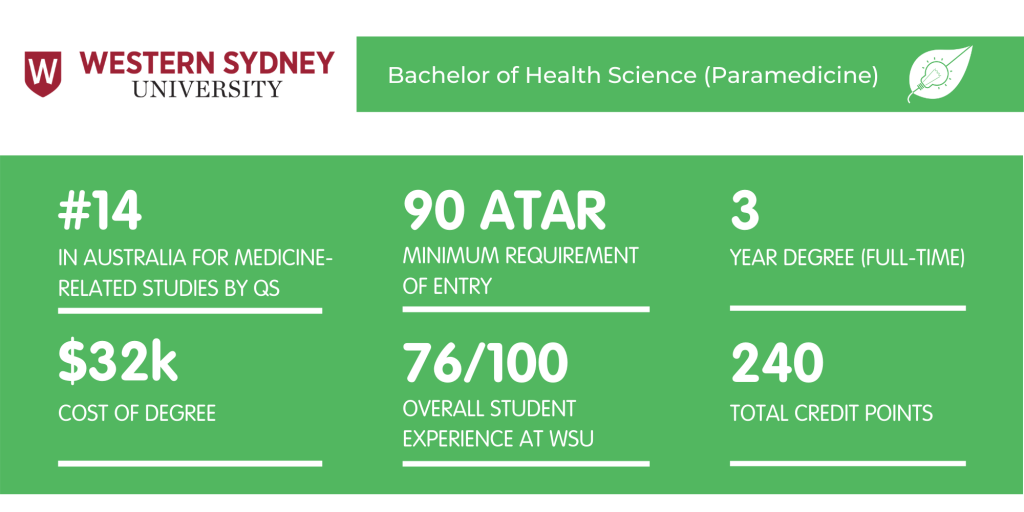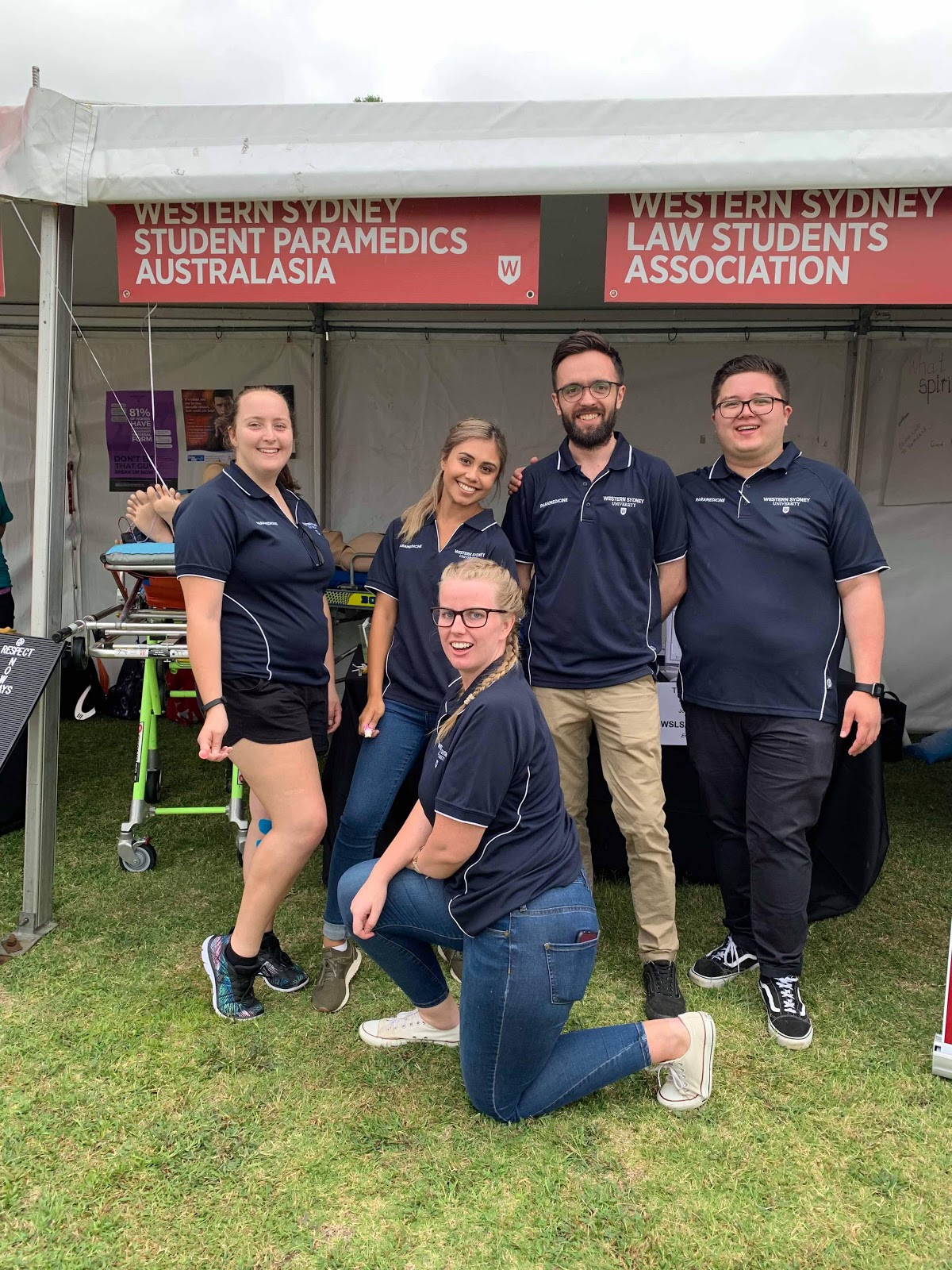Are you interested in studying a Bachelor of Health Science (Paramedicine) at WSU? Could you be the next person to literally save the day and people’s lives?
But, before you get to that, do you know all the ins and outs of the degree? Don’t worry — we do! We’ll cover everything from placements to assessments and uni culture.
Keep reading below!
What is a Bachelor of Health Science (Paramedicine) at WSU?
Core Units for this Degree
How to Get into Paramedicine at WSU
What’s the Teaching Format?
What’s the Faculty and Culture Like?
What is a Bachelor of Health Science (Paramedicine) at WSU?
Paramedicine at WSU will give you a taste and understanding of what it’s like to be a paramedic! Students will be exposed to different modes of teaching, such as practicals, tutorials and lectures, on how to be a well-rounded responder who will act quickly with care.
This degree is great for someone who loves to be challenged, loves helping people and someone who is able to rise to the occasion and think quickly!
Those taking on Paramedicine at WSU will have the luxury of studying in the state of the art Paramedicine building, where they’ll be able to learn and develop practical skills.
Career paths
Graduating from a Bachelor of Health Science (Paramedicine) will provide you with quite a few career options when entering the real world. The main career that people think of when they think of this degree is a paramedic!
But, there are other career options too, which include:
-
- Paramedic educator
- Further study into academia
- Policy writing and revising in the health sector
Core Units for this Degree
Since Paramedicine is essentially a major within the Bachelor of Health Science, you’ll be taking on the exact same subjects as other students in your cohort — your core units.
Some of the core units you will encounter include:
| Core Units | Description |
|---|---|
| Introduction to Paramedicine | This unit gives students a scope of what this degree will be like! It will provide students with a grasp on concepts and ideas that will become valuable to their further learning. |
| Communication in Health | Paramedicine at WSU not only prepares students to be excellent paramedics, but also inspires students to become empathetic, tolerant and effective communicators. This unit covers the diverse nature of situations that paramedics can find themselves in, and effective communication strategies to navigate these situations! |
| Population Health and Society | This unit focuses on the macro-level of society. Concepts such as disease, population health and general wellbeing will be examined. |
“Second year, in a nutshell, we are taught more in-depth with pathophysiology. Third year is more practical and consists of 9 weeks’ worth of placement — putting the pieces together as to what makes a safe clinician.
Your preceptors on road will determine whether or not you are equipped to graduate and practice on-road at the end of the year, which is exciting yet high responsibility.” — Christina
Placements
Fortunately, this degree gives students the opportunity to put theory into practice through compulsory placements which allow students to grow and learn, through shadowing and mirroring paramedics. WSU offers a wide range of locations for students to complete their placements — you could find yourself studying in New Zealand or even Finland!
Students will complete two non-emergency placements first (Patient Transport and Interprofessional), both lasting a week in duration. Then, students will complete a three week placement after the first year of study and a four week placement in emergency!
In the final year of study, students will complete a five week emergency placement. So if you’re worried about not having enough experience before entering the workforce, WSU has you covered!
As mentioned before, students will have options for where they can complete their placements, but they’ll have to do them while studying their other subjects. It’s important to stay on top of your work and if you feel you aren’t understanding something because you were away on placement, ask for help!
How to Get into Paramedicine at WSU
The ATAR cut off for guaranteed entry for the Bachelor of Health Science (Paramedicine) is 90. However, if you did not achieve this ATAR, there are other ways to gain entry into this degree!
Alternate Pathways
The College
Achieving an ATAR of 90 is definitely not easy, so if Paramedicine is what you’re most passionate about, you can initially complete a Diploma in Health Science at The College. Studying here will mirror the university program taught at WSU, but students will be well-supported in much smaller and more intensive classes!
Once students have successfully completed their first year at The College, they will gain admission into their desired course.
HSC True Reward Early Offer Program
If you don’t want to stress too much about your HSC exam results, this program can put you at ease by giving you the option of early entry. Rather than looking at your scaled results from the HSC, WSU will examine your Year 11 or Year 12 marks and reports.
However, if students choose to use their Year 11 results, they will still need to complete the HSC for admission into the program.
Assumed Knowledge
Within this degree there is assumed knowledge — it’s assumed that students have completed a HSC level of understanding for certain subjects! These subjects are any 2 units of English, as well as Mathematics.
Scholarships
WSU offers a wide range of scholarships. To see if you are eligible for any, check out the Scholarships Calculator Tool here!
What’s the Teaching Format?
This degree at WSU is delivered through semesters, meaning that there are two main academic periods each year. Paramedicine is also taught through a combination of lectures, tutorials and practicals, so theory is always backed up with the opportunity to put things into practice!
Class Structure
Lectures
Lectures are a given, regardless of the subject you’re taking. These classes involve a lecturer presenting topics and ideas relevant to paramedicine, and will usually inform content for tutorials and pracs.
Depending on the unit though, length times will vary from 1-3 hours. Since it’s also a small cohort, there’s typically no more than 160 students in each lecture!
Tutorials
Tutorials allow students to delve deeper into the knowledge they have acquired within their lectures. Students will have the opportunity to respond to mock patients’ injuries, write reports and do group work — they can also ask teachers any questions they may have!
Within a tutorial, there are usually around 20 people, but there will be a cap at 30 students!
Practicals
Pracs are held within the purpose-built Paramedicine lab with various different types of simulations and situations mocked out! Students will have to respond to these situations in a timely and effective manner.
You will need to embrace your inner actor, performing as the paramedic, patient or even the bystander — mocking real-life situations you may come across in your paramedic career! Within practical classes, generally there will be no more than 12 to 20 students.
How much time do you spend on campus?
The number of contact hours differs for each unit, but you can expect to be on campus for a maximum of 20 hours each week!
Interested in the pros and cons of this degree? Check out our article here!
Assessments
Within Paramedicine, you can be assessed through literature reviews, presentations, exams, OSCEs (prac exams — there are resits if you fail, but strictly only one), essays, portfolios and reflective assessments pre and post-placement.
OSCE stands for Objective Structured Clinical Examination. To be assessed in an OSCE style, you will be given a hypothetical situation such as a car accident. You will then be assessed on your ability to assess the situation and react appropriately.
Skills That You Refine and Learn
As a Paramedicine student, there are many different skills you’ll develop! Christina tells us about her experiences gained from this degree.
“In a nutshell, Paramedicine involves putting pieces of pathophysiology and biology together, mapping out what condition a person has and treating it accordingly. You learn how to respond to emergencies involving patients with acute and subacute health problems in a range of diverse and uncontrolled settings.
You also become familiar with dealing with health complaints that span the spectrum of illness and injury severity and complexity.
The course uses blended innovative learning and assessment strategies, in conjunction with clinical placement to develop clinical decision-making skills. The course equips students to work effectively as a paramedic in either a state service, the private sector or the defence forces.” — Christina
What’s the Faculty and Culture Like?
The Paramedicine Faculty is close-knit with extremely dedicated and enthusiastic teaching staff! Students also share this enthusiasm and dedication, so it’s not hard to become good friends with members of your cohort.
As this faculty and cohort are small — usually no more than 160 students each year — you will have the opportunity to get to know lots of people closely through study sessions or Parasoc bar crawls!
Societies
Western Sydney Paramedicine Society, or Parasoc for short, is a society dedicated to spreading information to fellow students, showcasing placement and job opportunities and just hosting fun events! This society is run by students for students — they know exactly what you are going through study wise.
ParaSoc at a WSU fair — Image provided by Christina
Support Programs
WSU hosts the mentoring program, MATES, which is aimed at first year uni students and gives them the opportunity to connect with other first year students and older mentors. MATES allows students to ask questions, connect and have fun in a supportive environment!
PASS is another program that WSU organises for students who would like academic help. These Peer Assisted Study Sessions are run by students for students with the aim of boosting academic results, as well as making friends along the way!
WSU Paramedicine’s UPSTREAM Program
UPSTREAM stands for ‘Undergraduate Paramedic Student Research Engagement Academy’. Interviewee, Christina, participated in the program and shares her experience.
“This was one of the best decisions I made when I started. You formulate a group, propose a research question and investigate it together with the supervision and guidance of paramedic academics.
The pilot study our team finished was presented at the Australasian College of Paramedicine Conference and won in the best research awards out of 45 other abstracts. This was the 5th consecutive year WSU students from UPSTREAM won this award, confirming the stance as the leading program during undergraduate study.
Contributing to the realm of improving paramedic practice was definitely one of the highlights of the degree.” — Christina
Matilda Elliott is a Content Writer at Art of Smart and a Communication graduate with a major in Journalism at Western Sydney University. You can find some of her published work in a range of platforms including SBS World News, The Music Network and within her own creative exploits with her twin sister. Matilda is a lover of listening, helping people to tell their stories, making genuine connections, clowning around in her circus troupe and dancing like no one is watching at live music shows!







